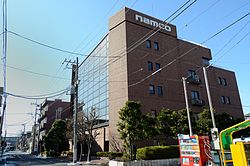
Back نامكو Arabic نامكو ARZ Namco AST نامکو AZB Namco Catalan Namco Danish Namco German Namco Spanish Namco Basque نامکو Persian
Logo (reused by Bandai Namco Amusements for its arcade chain of the same name) | |
 Headquarters in Ōta, Tokyo | |
Native name | 株式会社ナムコ |
|---|---|
Romanized name | Kabushiki-gaisha Namuko |
| Formerly |
|
| Company type | Subsidiary |
| Industry | Video games |
| Founded | June 1, 1955 |
| Founder | Masaya Nakamura |
| Defunct | March 31, 2006 |
| Fate | Merged with Bandai's video game operations to form Namco Bandai Games |
| Successor | Bandai Namco Entertainment |
| Headquarters | , Japan |
Area served | Worldwide |
Key people |
|
| Products | Video games |
| Parent | Namco Bandai Holdings (2005–2006) |
| Divisions |
|
| Subsidiaries |
|
| Website | https://bandainamco-am.co.jp/ |
Namco Limited[a] was a Japanese multinational video game and entertainment company, headquartered in Ōta, Tokyo. It held several international branches, including Namco America in Santa Clara, California, Namco Europe in London, Namco Taiwan in Kaohsiung, and Shanghai Namco in mainland China.
Namco was founded by Masaya Nakamura on June 1, 1955, as Nakamura Seisakusho,[b] beginning as an operator of coin-operated amusement rides. After reorganizing to Nakamura Seisakusho Co., Ltd. in 1959, a partnership with Walt Disney Productions provided the company with the resources to expand its operations. In the 1960s, it manufactured electro-mechanical arcade games such as the 1965 hit Periscope. The name comes from Nakamura Manufacturing Company. It entered the video game industry after acquiring the struggling Japanese division of Atari in 1974, distributing games such as Breakout in Japan. The company renamed itself Namco in 1977 and published Gee Bee, its first original video game, a year later. Among Namco's first major hits was the fixed shooter Galaxian in 1979. It was followed by Pac-Man in 1980. Namco prospered during the golden age of arcade video games in the early 1980s, releasing popular titles such as Galaga, Xevious, and Pole Position.
Namco entered the home console market in 1984 with conversions of its arcade games for the MSX and the Nintendo Family Computer. Its American division majority-acquired Atari Games in 1985, before selling a portion of it in 1987 following disagreements between the two companies. Arguments over licensing contracts with Nintendo led Namco to produce games for competing platforms, such as the Sega Genesis, TurboGrafx-16, and PlayStation.
Namco continued to produce hit games in the 1990s, including Ridge Racer, Tekken, and Taiko no Tatsujin. Namco endured numerous financial difficulties in the late 1990s and 2000s as a result of the struggling Japanese economy and diminishing arcade market. In 2005, Namco merged with Bandai to form Namco Bandai Holdings, a Japanese entertainment conglomerate. It continued producing games until it was merged into Namco Bandai Games in 2006.
Namco produced several multi-million-selling game franchises, such as Pac-Man, Galaxian, Tekken, Tales, Ridge Racer, and Ace Combat. It operated video arcades and amusement parks globally, and also produced films, toys, and arcade cabinets and operated a chain of restaurants. Namco is remembered in retrospect for its unique corporate model, its importance to the industry, and its advancements in technology. Its successor, Bandai Namco Entertainment, and its subsidiaries continue to use the Namco brand for their video arcades and other entertainment products.
Cite error: There are <ref group=lower-alpha> tags or {{efn}} templates on this page, but the references will not show without a {{reflist|group=lower-alpha}} template or {{notelist}} template (see the help page).
© MMXXIII Rich X Search. We shall prevail. All rights reserved. Rich X Search